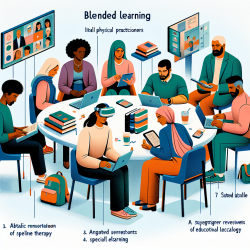Implementing Theodor Hellbrügge's Research for Improved Pediatric Outcomes

The legacy of Theodor Hellbrügge in the field of pediatric care is monumental. His research and contributions have provided invaluable insights into the development and prehabilitation of children with disabilities. One of his most significant contributions is the introduction of chronobiology into pediatric practice. This blog explores how practitioners can improve their skills by implementing the outcomes of Hellbrügge's research and encourages further investigation into this groundbreaking field.
Understanding Chronobiology and Its Importance
Chronobiology is the study of biological rhythms and their effects on health. Hellbrügge's research highlights the importance of circadian rhythms—24-hour cycles that govern physiological processes—in the development and rehabilitation of children. His findings suggest that early diagnosis and intervention, timed according to these biological rhythms, can significantly improve outcomes for children with disabilities.
Key Takeaways from Hellbrügge's Research
Hellbrügge's work emphasizes the need for a data-driven approach to pediatric care. Here are some key takeaways:
- Early Diagnosis and Intervention: Hellbrügge advocated for early diagnosis and intervention, particularly for children with hearing impairments. His research showed that early speech therapy could help deaf children develop normal speech.
- Importance of Timing: The timing of interventions is crucial. Hellbrügge's studies on corticosteroid therapy in children with asthma demonstrated that the timing of medication could drastically affect treatment outcomes.
- Integration of Chronobiology: Incorporating chronobiology into pediatric practice can help identify and address "silent handicaps" or physiological variabilities that may not be immediately apparent.
Implementing Chronobiology in Pediatric Practice
To implement the outcomes of Hellbrügge's research, practitioners can follow these steps:
- Conduct Longitudinal Monitoring: Regular monitoring of vital signs such as blood pressure and heart rate can help detect chronome alterations that may indicate underlying health issues.
- Utilize Data-Driven Interventions: Use data to determine the optimal timing for interventions. For example, timing speech therapy sessions according to the child's circadian rhythms can enhance the effectiveness of the treatment.
- Educate Parents and Caregivers: Inform parents about the importance of biological rhythms and how they can support their child's development by maintaining consistent daily routines.
Encouraging Further Research
While Hellbrügge's contributions have laid a solid foundation, there is still much to explore in the field of chronobiology. Practitioners are encouraged to engage in further research to better understand the complexities of biological rhythms and their impact on pediatric care. Areas for future research include:
- Longitudinal Studies: Conducting long-term studies to track the effects of chronobiology-based interventions on child development.
- Transdisciplinary Approaches: Collaborating with experts in other fields, such as physics and environmental science, to explore the broader implications of chronobiology.
- Technological Advancements: Utilizing advanced technologies for more precise monitoring and analysis of biological rhythms.
Conclusion
Theodor Hellbrügge's pioneering work in chronobiology offers valuable insights for improving pediatric outcomes. By integrating his findings into practice, practitioners can enhance the effectiveness of their interventions and contribute to the overall well-being of children. For those interested in delving deeper into Hellbrügge's research, the original paper can be accessed here:
Theodor Hellbrügge: 85 years of age – Ad multos transannos, sanos, fortunatos et beatos.
Citation: Halberg, F., Cornélissen, G., Katinas, G., Schwartzkopff, O., & Johnson, D. (2005). Theodor Hellbrügge: 85 years of age – Ad multos transannos, sanos, fortunatos et beatos. Journal of Circadian Rhythms, 3(1), 2. https://doi.org/10.1186/1740-3391-3-2










